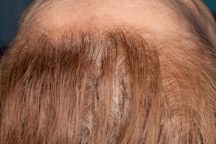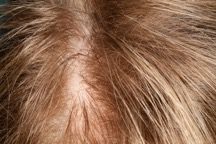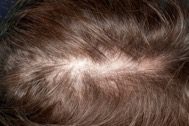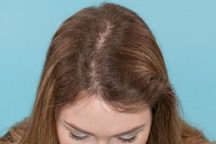Androgenetic alopecia, or male or female pattern alopecia, is the most common type of hair loss. Incidentally, please do not accidentally insult your female clients by telling them that they have “male pattern hair loss.”
According to an article published in the Journal of the American Academy of Dermatology, approximately 40% of women, and 50% of men, will experience androgenetic alopecia by the age of 50. In men, androgenetic alopecia presents as a bitemporal recession of the hairline and thinning at the vertex of the scalp. The male pattern thinning gradually progresses to take the hair from the frontal hairline and extend back to the vertex scalp. The rim of hair over the ears to the back of the scalp is spared. In women, androgenetic alopecia presents with preservation of the frontal hairline and widening of the part behind the hairline in an inverted Christmas tree pattern. In men, we know that DHT, which is a byproduct of testosterone, leads to miniaturization and of the follicles that have DHT receptors.




In women, DHT may play a role, especially when women are post-menopausal. Many other factors can also contribute to androgenetic alopecia in women. For example, stress, vitamin deficiencies, scalp inflammation, and hormonal fluctuations all seem to exacerbate female pattern alopecia. If you are treating a client, and notice that she has female pattern alopecia, it’s important to send the client to the dermatologist for a full evaluation so that any internal factors may be treated.
Regarding treatment options for male pattern alopecia, men should be on a DHT blocker, like saw palmetto or finasteride. Minoxidil is the only FDA-approved topical treatment for alopecia. All of the studies suggest that combining minoxidil and a DHT blocker yields the most successful treatment. Additional treatments such as red-light therapy, PRP (platelet-rich plasma), exosomes, and lasers have also proven to be helpful. Hair transplantation is a surgical treatment option.
To treat women with female pattern hair loss, it is important to identify and address all underlying contributing factors. Minoxidil is still the only topical treatment option that is FDA-approved, but it may cause side effects including scalp inflammation, dandruff, and unwanted facial hair growth. The best approach to treating female pattern hair loss is a comprehensive approach. It is recommended to improve blood flow to the scalp, calm inflammation, and stop shedding. Vitamin supplementation and correcting any underlying hormonal imbalances is also important.
The ReTress system includes a shampoo, conditioner, serum and vitamin supplements. ReTress uses all-natural active ingredients to help improve blood flow to the scalp, calm scalp inflammation, and reduce shedding. ReTress is free of parabens, harsh sulfates, phthalates, minoxidil, and synthetic fragrance. Red light therapy, lasers, PRP, exosomes, microneedling and hair transplantation are all helpful in combatting female pattern alopecia.


